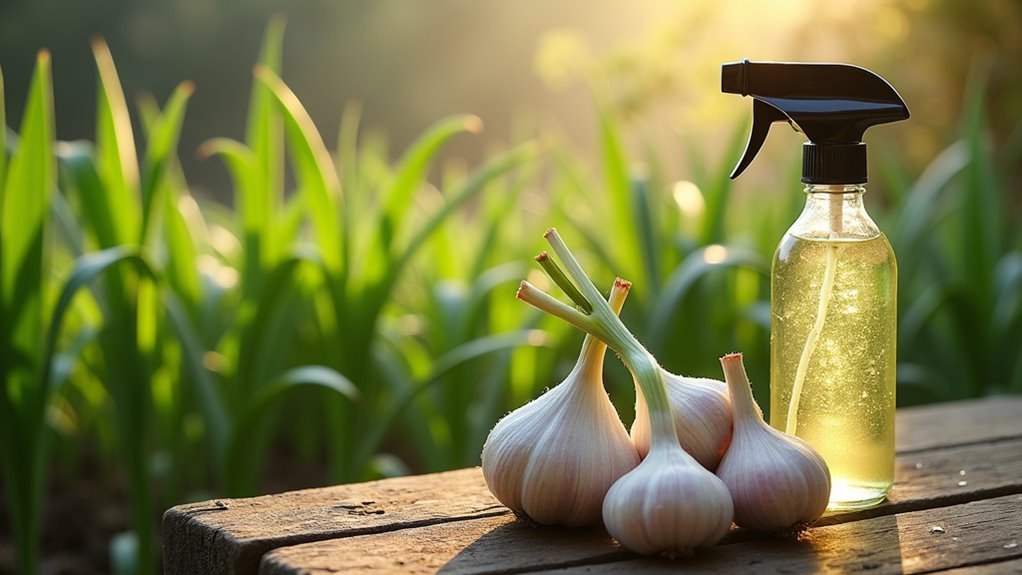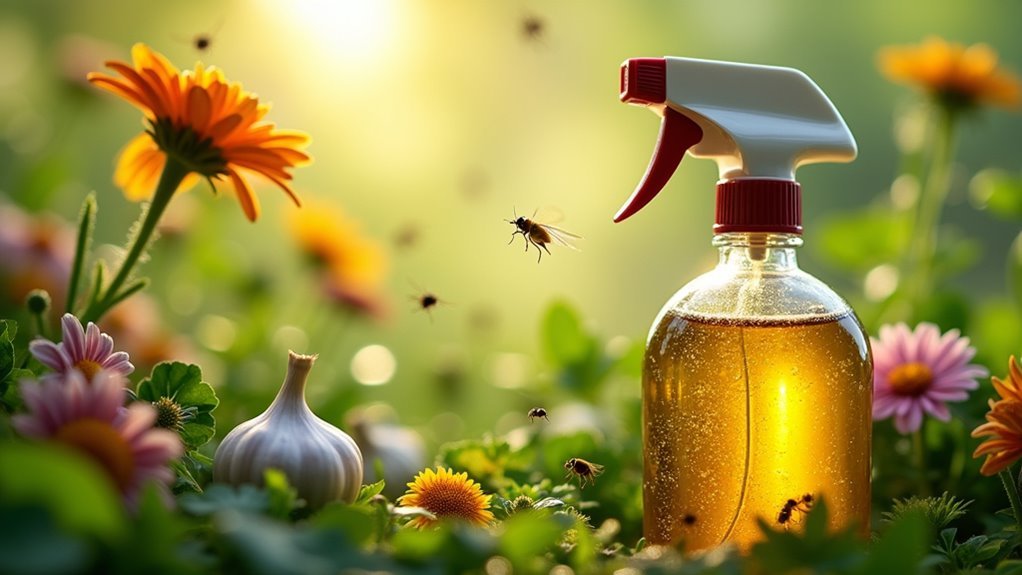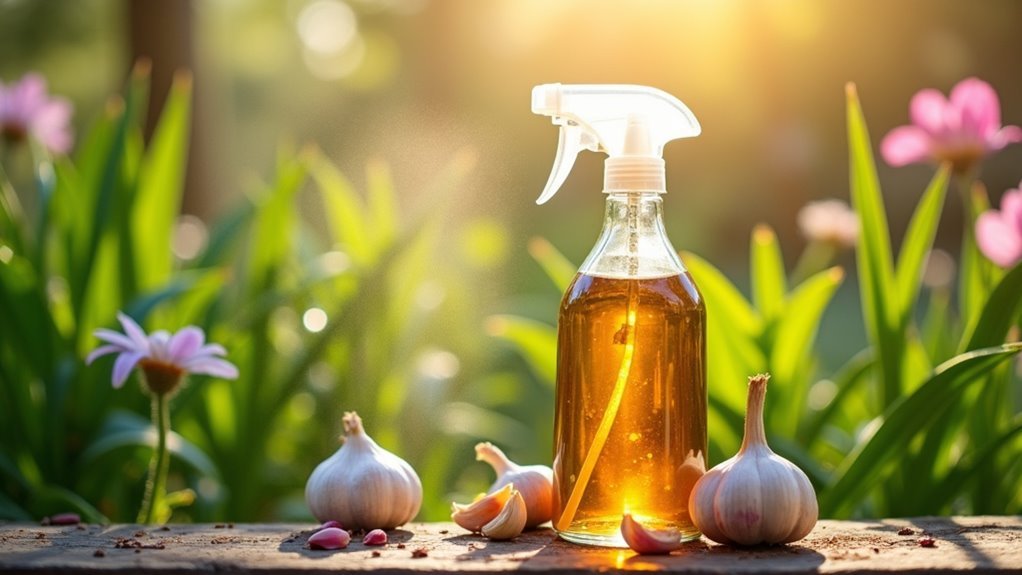When you crush garlic, it releases powerful sulfur compounds like dimethyl trisulfide and diallyl disulfide that create a pungent barrier pests can’t tolerate. These compounds disrupt insects’ olfactory senses, making it impossible for them to navigate or locate your plants for feeding and egg-laying. The spray effectively targets soft-bodied pests like aphids, spider mites, and caterpillars while masking the attractive scents that typically draw them to your garden, providing extensive protection through multiple biological mechanisms.
The Science Behind Garlic’s Pest-Fighting Properties

When you crush a garlic clove, you’re releasing powerful sulfur compounds like dimethyl trisulfide, diallyl disulfide, and diallyl sulfide that naturally repel insects through their pungent odor.
Crushing garlic releases sulfur compounds like dimethyl trisulfide and diallyl disulfide that naturally repel insects with their pungent odor.
These compounds don’t just smell bad to pests—they’re actually toxic to them. Research shows garlic can kill yellow mealworm larvae and spined soldier bugs while reducing their populations effectively.
Your garlic spray works by masking the attractive scents that draw pests to your plants. When insects can’t detect those appealing odors, they won’t feed on foliage or lay eggs nearby.
Studies dating back to the 1970s confirm garlic’s effectiveness against synthetic pesticides. You’ll find it particularly successful against aphids, spider mites, and beetles, making it a proven organic solution for protecting your garden naturally.
Which Garden Pests Are Vulnerable to Garlic Spray
You’ll find garlic spray works effectively against soft-bodied pests like aphids, spider mites, and slugs, as well as beetles and caterpillars that rely on scent to navigate your garden.
The sulfur compounds in garlic disrupt these pests’ sensory systems, making it particularly lethal to yellow mealworm larvae and spined soldier bugs.
However, garlic spray isn’t a silver bullet – some pests show resistance, and you’ll need to understand which ones respond best to this natural treatment.
Common Vulnerable Pests
Garlic spray targets several destructive garden pests that commonly plague home gardens and crops. You’ll find it particularly effective against aphids, which drain plant juices and weaken foliage.
Spider mites, those tiny web-spinning pests that cause leaf stippling, also succumb to garlic’s potent compounds. Slugs, notorious for chewing holes in leaves overnight, retreat from garlic-treated areas.
The spray works exceptionally well on cabbage fly adults and their eggs, protecting cruciferous vegetables from infestations.
Green peach aphids, which spread plant viruses, can’t tolerate garlic’s sulfur-based compounds like diallyl disulfide. These common insects rely on scent to locate food sources, but garlic’s strong odor disrupts their navigation abilities.
Yellow mealworm larvae are particularly vulnerable, as garlic compounds prove toxic to them.
Garlic Spray Limitations
Despite its effectiveness against many common garden pests, garlic spray has notable limitations that you should understand before relying on it as your primary pest control method.
Certain insects like silverleaf whiteflies and rosy apple aphids show resistance to garlic’s sulfur compounds, making this garlic repellent less reliable against these species. Additionally, some weevils and beetles don’t respond to garlic spray at all, limiting its universal application.
The strong scent that makes garlic effective against smaller insects won’t deter larger mammals like rabbits and deer effectively.
You’ll need to complement garlic spray with other pest control strategies since it won’t eliminate all pest populations. Think of garlic as one tool in your integrated pest management approach rather than a complete solution.
Essential Sulfur Compounds That Repel Insects

You’ll find three key sulfur compounds in garlic that make it so effective against garden pests: dimethyl trisulfide, diallyl disulfide, and diallyl sulfide.
These compounds work by disrupting insects’ olfactory senses and masking the attractive scents that normally draw pests to your plants.
What’s particularly powerful is that these sulfur-based molecules don’t just repel insects—they can actually prove toxic to certain pest species while remaining safe for beneficial garden visitors.
Dimethyl Trisulfide Properties
At the heart of garlic’s pest-fighting power lies dimethyl trisulfide, a potent sulfur compound that creates the characteristic pungent aroma responsible for repelling garden invaders.
This powerful compound doesn’t just mask attractant scents—it actively disrupts pest behavior and biology. You’ll find dimethyl trisulfide effectively deters aphids, spider mites, and beetles while simultaneously inhibiting their feeding patterns.
What makes this compound particularly valuable is its dual action: it can repel and kill various garden pests.
Research demonstrates its toxicity to insect larvae, including yellow mealworm larvae and spined soldier bugs, disrupting their entire life cycle.
Diallyl Compound Effects
Beyond dimethyl trisulfide, garlic contains powerful diallyl compounds—including diallyl sulfide and diallyl disulfide—that create an additional layer of pest protection through their intense sulfur-based odors.
These compounds disrupt insects’ sensory receptors, making it nearly impossible for pests to locate your plants and food sources.
When you apply garlic spray, diallyl compounds act as natural insecticides, proving toxic to yellow mealworm larvae and spined soldier bugs.
You’ll see significant reductions in pest populations, particularly gall midges, cabbage fly adults, and green peach aphids.
The pungent nature of these sulfur compounds masks plant scents that typically attract unwanted insects, creating a protective barrier around your crops while preserving beneficial insects when you apply the treatment judiciously.
Sulfur Toxicity Mechanisms
Garlic’s sulfur compounds don’t just mask plant scents—they actively poison insects through multiple toxic pathways that target their cellular functions.
When you crush garlic cloves to make spray, you release dimethyl trisulfide and diallyl disulfide that penetrate insect exoskeletons and disrupt essential metabolic processes. These sulfur toxicity mechanisms interfere with cellular respiration and enzyme function, causing organ failure in vulnerable pests like yellow mealworm larvae and spined soldier bugs.
The compounds also attack insects’ nervous systems, impairing their ability to feed, navigate, and reproduce.
You’ll find that garlic’s multi-pronged toxic assault makes it nearly impossible for pests to develop resistance, unlike synthetic pesticides that target single pathways. This thorough cellular damage explains why garlic spray achieves high mortality rates against diverse garden pests.
How Garlic Disrupts Pest Sensory Systems

When you spray garlic in your garden, you’re releasing powerful sulfur compounds like diallyl sulfide that create a sensory nightmare for unwanted pests. These volatile compounds overwhelm insects’ olfactory receptors, making it impossible for them to detect food sources or locate potential mates.
| Pest Type | Sensory Impact | Behavioral Response |
|---|---|---|
| Aphids | Masked plant scents | Avoidance behaviors |
| Beetles | Disrupted navigation | Feeding inhibition |
| Various insects | Confused receptors | Reduced reproduction |
The pungent aroma masks attractive plant scents that normally guide pests to their targets. Research shows these sulfur compounds don’t just confuse insects—they’re actually toxic to many species. This dual action means garlic can help repel existing pests while preventing new infestations, creating a natural protective barrier around your plants.
Basic Garlic Spray Recipe for Garden Protection
Creating your own garlic spray requires just a few simple ingredients you likely have at home.
To make garlic spray, blend 4 cloves of minced garlic with 1 pint of water and let it steep for 24 hours before straining. Next, add 1 tablespoon of mineral oil and 1 teaspoon of dish soap to enhance efficacy and help the mixture adhere to plant surfaces.
For application, dilute your concentrated mixture by adding 2 tablespoons to a spray bottle filled with 1 pint of water.
This DIY garlic spray should be applied to both tops and undersides of leaves, targeting affected plants to repel aphids and spider mites effectively.
Reapply weekly or after rainfall to maintain pest-fighting effectiveness throughout your garden.
Enhanced Garlic Spray With Hot Pepper and Onion
While the basic garlic spray provides solid pest protection, you can greatly amplify its power by incorporating hot pepper and onion into your mixture.
This enhanced DIY spray creates a triple-threat formula that targets multiple pest vulnerabilities simultaneously. The hot pepper’s capsaicin effectively repels caterpillars and deer, while onion’s sulfur compounds mirror garlic’s deterrent properties.
Together, these ingredients form a multifaceted barrier that confuses and disrupts pest feeding patterns, making your plants less attractive to infestations.
Benefits of this enhanced garlic combination include:
- Broader pest protection against insects, caterpillars, and larger garden invaders
- Synergistic compound interaction for maximum effectiveness
- Reduced dependence on chemical pesticides
- Cost-effective organic solution promoting healthier garden ecosystems
Proper Application Techniques for Maximum Effectiveness
Even the most potent garlic spray won’t deliver ideal results without proper application techniques.
You’ll want to apply your garlic spray during evening hours to reduce leaf burn risk and target nocturnal pests effectively. Maintain a 15-30 cm distance from foliage while spraying to guarantee even coverage without overwhelming plants.
Focus on both leaf tops and undersides, since many pests hide beneath leaves where they’re harder to detect. This thorough coverage maximizes your pest deterrence efforts.
Don’t forget leaf undersides—hidden pests lurk where you can’t see them, making thorough spray coverage essential for maximum protection.
You’ll need to reapply the spray every few days or immediately after rainfall, as water washes away garlic’s protective effects.
Always test new batches on a single leaf first to monitor for adverse plant reactions before treating entire gardens.
Timing and Frequency of Garlic Spray Treatments
Knowing when and how often to apply garlic spray makes the difference between successful pest control and wasted effort.
You’ll achieve excellent results by timing your applications strategically and maintaining consistent treatment schedules.
Apply garlic spray during evening hours to prevent leaf burn from sunlight while ensuring thorough coverage on both leaf surfaces.
The timing and frequency of garlic spray treatments depends on your garden’s specific pest pressure and environmental conditions.
- Weekly applications: Maintain consistent protection with regular weekly treatments throughout the growing season
- Increase frequency: Apply twice weekly during heavy rainfall or peak pest activity periods
- Post-rain reapplication: Reapply every few days after rainfall to restore spray potency
- Monitor and adjust: Watch for pest activity signs and modify treatment frequency accordingly
Always test new batches before full application when you make a DIY garlic spray solution.
Combining Garlic Spray With Companion Planting
Strategic companion planting transforms your garlic spray into a powerful dual-defense system against garden pests. When you combine garlic spray treatments with strategic plant partnerships, you’ll create a diverse ecosystem that confuses pests and makes it harder for them to locate their preferred hosts. The strong garlic odor masks plant scents that typically attract unwanted insects, while companion plants add their own repellent properties.
| Companion Plant | Target Pests | Best Paired With |
|---|---|---|
| Garlic | Aphids, Flea Beetles | Roses, Cole Crops |
| Marigolds | Various Garden Pests | Tomatoes, Peppers |
| Basil | Flies, Mosquitoes | Peppers, Tomatoes |
Using garlic to help establish these partnerships maximizes your pest management success. This companion planting approach reduces your reliance on chemical treatments while boosting overall garden health and yields.
Storage and Shelf Life of Homemade Garlic Solutions
You’ll need to store your homemade garlic spray correctly to maintain its pest-fighting power and avoid wasting your efforts.
Your garlic solution won’t last indefinitely, so understanding its maximum shelf life helps you plan when to make fresh batches.
Watch for specific deterioration signs that signal it’s time to discard your current mixture and start over.
Proper Storage Conditions
Once you’ve prepared your homemade garlic spray, proper storage becomes crucial for maintaining its pest-fighting effectiveness.
Your homemade garlic solutions require specific proper storage conditions to preserve their potency and prevent degradation.
Store your garlic spray in these ideal conditions:
- Cool, dark environment – Keep solutions in your refrigerator to maintain maximum effectiveness against garden pests.
- Airtight containers – Use sealed containers to prevent contamination and air exposure that degrades the mixture.
- Regular monitoring – Check stored solutions for separation, unusual odors, or other spoilage signs before each use.
- Fresh preparation schedule – Replace your garlic spray every 1-2 weeks since potency decreases over time.
Following these storage guidelines guarantees your garlic spray remains effective when you need it most for pest control.
Maximum Shelf Life
Understanding your garlic spray’s maximum shelf life helps you maintain effective pest control while avoiding weakened or potentially harmful solutions.
Your homemade garlic solutions remain effective for only 1-2 weeks when refrigerated. Beyond this timeframe, the pest-repelling compounds deteriorate considerably, reducing your spray’s ability to deter garden invaders.
Always label your spray bottle with the preparation date to track freshness accurately. You’ll know it’s time to discard the solution when it develops an off smell or unusual appearance – these signs indicate the garlic has degraded beyond safe use.
For best results, prepare fresh batches using recently purchased garlic rather than older bulbs that may have already lost potency. This guarantees maximum effectiveness against pests while maintaining safety standards.
Signs of Deterioration
How can you tell when your homemade garlic spray has passed its prime? Recognizing deterioration signs guarantees you won’t apply ineffective or harmful solutions to your plants. Proper storage in cool, dark places helps maintain quality, but even refrigerated garlic sprays eventually break down.
Watch for these key deterioration indicators:
- Off smells – Any unusual or rancid odors signal the solution has spoiled
- Color changes – Discoloration from the original appearance indicates breakdown
- Separation or sediment – Visible layers or particles may require re-blending or disposal
- Age beyond two weeks – Effectiveness diminishes considerably after this timeframe
Don’t risk your garden’s health by using questionable garlic spray. When in doubt, discard the old batch and prepare a fresh solution for maximum pest-fighting effectiveness.
Safety Considerations When Using Garlic Pesticides
Several important safety measures require your attention when applying garlic-based pesticides to guarantee both plant health and environmental responsibility.
When implementing safety considerations for garlic pesticides, you’ll need to test the spray on a small, hidden plant section first to check for adverse reactions before full application.
Proper dilution prevents leaf yellowing and plant damage from concentrated mixtures. You should apply garlic spray selectively, avoiding peak activity times for beneficial insects to protect these helpful species.
Don’t spray near harvest time, as it’ll impart garlic flavor to your produce.
Store unused garlic spray in cool, dark locations to maintain effectiveness and prevent active compound degradation.
These precautions make certain successful pest control while protecting your garden ecosystem.
Limitations and Pests That Resist Garlic Treatment
While garlic spray offers an effective, natural pest control method when used properly, it won’t solve every garden pest problem you’ll encounter.
Understanding which pests that resist garlic treatment helps you develop more thorough control strategies for your garden.
Several pest species show resistance to garlic’s pungent compounds:
- Certain beetles and weevils continue infesting plants despite regular garlic spray applications
- Rosy apple aphids and silverleaf whiteflies demonstrate strong resistance to garlic intervention methods
- Mammals like rabbits and deer aren’t deterred by garlic’s odor and continue feeding on treated plants
- Various insect species don’t respond to garlic’s smell, creating gaps in your pest control coverage
Don’t rely on garlic spray as your only pest management solution, since it’s not universally effective against all garden threats.
Frequently Asked Questions
Why Does Garlic Repel Pests?
You’ll find garlic repels pests because its sulfur compounds create a pungent odor that masks plant scents attracting insects. This strong smell deters aphids, beetles, and slugs while being toxic to certain pest species.
What Is Garlic Spray Good for in the Garden?
You’ll find garlic spray effectively controls aphids, slugs, and spider mites while preventing diseases like powdery mildew. It’s an organic, safe pesticide that masks plant scents attracting pests, protecting your garden naturally.
How Do You Make Garlic Spray for Pest Control?
You’ll crush 4-5 garlic cloves, mix with 4 cups water and dish soap drops. Strain the mixture, dilute 1:10 with water, then transfer to a spray bottle for application.
How Effective Is Garlic as a Pesticide?
You’ll find garlic’s quite effective against specific pests like aphids, spider mites, and gall midges. It’s toxic to certain insects and masks attractant scents, providing significant pest reduction when you apply it consistently.
In Summary
You’ve discovered that garlic spray’s sulfur compounds disrupt pests’ sensory systems, making it an effective natural deterrent for aphids, caterpillars, and many soft-bodied insects. You can easily make your own solution and enhance its effectiveness through companion planting. Remember that you’ll need to reapply regularly, and some pests won’t respond to garlic treatment. You’re choosing an eco-friendly approach that protects beneficial insects while controlling harmful garden pests naturally.





Leave a Reply